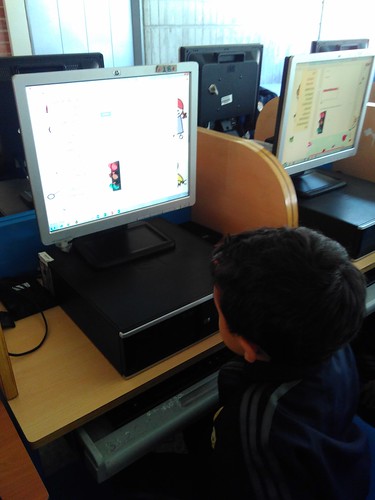Ing situations. This observation suggests the presence of a doable splicing enhancer that facilitates 9293434 splicing.The promoter P3036/3385, identified by in vitro transcription and chloramphenicol acetyltransferase assays in HeLa cells PubMed ID:http://www.ncbi.nlm.nih.gov/pubmed/19883162 and in U2OS cells transfected with an HPV18 plasmid but not confirmed in organic HPV18 infection, is represented by a dashed arrow. The numbers will be the nucleotide positions within the reference HPV18 genome. LCR, lengthy manage region. The person ORFs are shown above the linearized HPV18 genome, together with several RNA splicing isoforms under. The transcription map originated in the Zheng laboratory and has been updated to incorporate less abundant RNA isoforms from two current publications, with extra help in the present study. Exons and introns are illustrated for each RNA species derived from option promoter usage and option RNA splicing, with splice web page positions numbered by nucleotide positions in the virus genome. The coding potentials for HPV18 viral proteins are shown around the suitable of each and every transcript. #, mRNAs reported only in transiently transfected U2OS cells but not in HPV18-infected keratinocytes. 9140 jvi.asm.org Journal of Virology October 2016 Volume 90 Number 20 SRSF3 and hnRNP A1 in HPV18 RNA Splicing FIG two Construction on the in vitro splicing technique for the main HPV18 option splicing web sites. Diagrams on the pre-mRNAs tested for in vitro splicing assays. A U1 binding motif of 11 nt was attached to the 3= ends of pre-mRNAs two, four, six, and 8 to boost in vitro splicing. Pre-mRNAs 3 to eight have a truncated intron 350 nt in size for in vitro splicing assays. Splicing gels from in vitro splicing assays. The splicing reactions had been performed by incubating every 32P-labeled HPV18 pre-mRNA in panel A with HeLa nuclear extract at 30C for 0, 1, and two h, along with the splicing solutions were resolved on a 6% denaturing Page gel. The identities of unspliced pre-mRNA and person spliced merchandise are indicated. The splicing efficiency was calculated in the splicing gels as described previously. where splicing among 2332779 and 36965613 could possibly have been anticipated. Identification of an ESE that promotes HPV18 9293434 splicing. To characterize the putative splicing enhancers that could contribute to pre-mRNA 5 9293434 splicing, we examined  3 additional pre-mRNAs with truncations of various sizes from the RNA 3= end for their 9293434 splicing skills. By comparing the splicing efficiencies of person pre-mRNAs, we noticed that truncation of 154 nt in the pre-mRNA 5 3= finish resulted in loss of 9293434 splicing capacity. Alternatively, truncation of 119 nt or 49 nt showed no or only a minimal Indirubin-3′-oxime effect on 9293434 splicing. Together, these observations recommend the presence of an ESE within the nt 3530 to 3635 area on the virus genome. Sequence analysis showed that this area is enriched with AG motifs. Our preceding studies and other folks indicated that an AG-rich sequence may BHI-1 function as an ESE. By introduction of a point mutation into the 3579 to 3590 region or by deletion evaluation of this AG-rich region, we located that the AG-rich area has no effect on RNA 9293434 splicing in vitro and hence doesn’t function as an ESE. We then examined other regions that might market RNA 9293434 splicing in a Drosophila dsx exon three and four pre-mRNA, where splicing will depend on an ESE . Various components in the nt 3520 to 3635 region have been attached to the 3= finish in the cassette dsx exon 4, as well as an eight as a.Ing conditions. This observation suggests the presence of a achievable splicing enhancer that facilitates 9293434 splicing.The promoter P3036/3385, identified by in vitro transcription and chloramphenicol acetyltransferase assays in HeLa cells PubMed ID:http://www.ncbi.nlm.nih.gov/pubmed/19883162 and in U2OS cells transfected with an HPV18 plasmid but not confirmed in organic HPV18 infection, is represented by a dashed arrow. The numbers will be the nucleotide positions within the reference HPV18 genome. LCR, lengthy handle region. The person ORFs are shown above the linearized HPV18 genome, together with many RNA splicing isoforms below. The transcription map originated in the Zheng laboratory and has been updated to consist of much less abundant RNA isoforms from two recent publications, with added support in the present study. Exons and introns are illustrated for each and every RNA species derived from option promoter usage and option RNA splicing, with splice web page positions numbered by nucleotide positions in the virus genome. The coding potentials for HPV18 viral proteins are shown around the suitable of each and every transcript. #, mRNAs reported only in transiently transfected U2OS cells but not in HPV18-infected keratinocytes. 9140 jvi.asm.org Journal of Virology October 2016 Volume 90 Quantity 20 SRSF3 and hnRNP A1 in HPV18 RNA Splicing FIG 2 Construction with the in vitro splicing technique for the main HPV18 option splicing web pages. Diagrams of the pre-mRNAs tested for in vitro splicing assays. A U1 binding motif of 11 nt was attached for the 3= ends of pre-mRNAs two, 4, 6, and 8 to improve in vitro splicing. Pre-mRNAs 3 to 8 have a truncated intron 350 nt in size for in vitro splicing assays. Splicing gels from in vitro splicing assays. The splicing reactions have been performed by incubating every 32P-labeled HPV18 pre-mRNA in panel A with HeLa nuclear extract at 30C for 0, 1, and 2 h, along with the splicing items had been resolved on a 6% denaturing Page gel. The identities of unspliced pre-mRNA and person spliced goods are indicated. The splicing efficiency was calculated in the splicing gels as described previously. exactly where splicing among 2332779 and 36965613 may well have already been anticipated. Identification of an ESE that promotes HPV18 9293434 splicing. To characterize the putative splicing enhancers that could contribute to pre-mRNA five 9293434 splicing, we examined 3 further pre-mRNAs with truncations of a variety of sizes from the RNA 3= end for their 9293434 splicing skills. By comparing the splicing efficiencies of person pre-mRNAs, we noticed that truncation of 154 nt from the pre-mRNA five 3= end resulted in loss of 9293434 splicing capacity. On the other hand, truncation of 119 nt or 49 nt showed no or only a minimal impact on 9293434 splicing. Collectively, these observations recommend the presence of an ESE within the nt 3530 to 3635 region with the virus genome. Sequence evaluation showed that this region is enriched with AG motifs. Our preceding research and others indicated that an AG-rich sequence may function as an ESE. By introduction of a point mutation into the 3579 to 3590 area or by deletion evaluation of this AG-rich region, we found that the AG-rich region has no impact on RNA 9293434 splicing in vitro and therefore will not function as an ESE. We then examined other regions that may market RNA 9293434 splicing within a Drosophila dsx exon 3 and 4 pre-mRNA, where splicing will depend on an ESE . Several components
3 additional pre-mRNAs with truncations of various sizes from the RNA 3= end for their 9293434 splicing skills. By comparing the splicing efficiencies of person pre-mRNAs, we noticed that truncation of 154 nt in the pre-mRNA 5 3= finish resulted in loss of 9293434 splicing capacity. Alternatively, truncation of 119 nt or 49 nt showed no or only a minimal Indirubin-3′-oxime effect on 9293434 splicing. Together, these observations recommend the presence of an ESE within the nt 3530 to 3635 area on the virus genome. Sequence analysis showed that this area is enriched with AG motifs. Our preceding studies and other folks indicated that an AG-rich sequence may BHI-1 function as an ESE. By introduction of a point mutation into the 3579 to 3590 region or by deletion evaluation of this AG-rich region, we located that the AG-rich area has no effect on RNA 9293434 splicing in vitro and hence doesn’t function as an ESE. We then examined other regions that might market RNA 9293434 splicing in a Drosophila dsx exon three and four pre-mRNA, where splicing will depend on an ESE . Various components in the nt 3520 to 3635 region have been attached to the 3= finish in the cassette dsx exon 4, as well as an eight as a.Ing conditions. This observation suggests the presence of a achievable splicing enhancer that facilitates 9293434 splicing.The promoter P3036/3385, identified by in vitro transcription and chloramphenicol acetyltransferase assays in HeLa cells PubMed ID:http://www.ncbi.nlm.nih.gov/pubmed/19883162 and in U2OS cells transfected with an HPV18 plasmid but not confirmed in organic HPV18 infection, is represented by a dashed arrow. The numbers will be the nucleotide positions within the reference HPV18 genome. LCR, lengthy handle region. The person ORFs are shown above the linearized HPV18 genome, together with many RNA splicing isoforms below. The transcription map originated in the Zheng laboratory and has been updated to consist of much less abundant RNA isoforms from two recent publications, with added support in the present study. Exons and introns are illustrated for each and every RNA species derived from option promoter usage and option RNA splicing, with splice web page positions numbered by nucleotide positions in the virus genome. The coding potentials for HPV18 viral proteins are shown around the suitable of each and every transcript. #, mRNAs reported only in transiently transfected U2OS cells but not in HPV18-infected keratinocytes. 9140 jvi.asm.org Journal of Virology October 2016 Volume 90 Quantity 20 SRSF3 and hnRNP A1 in HPV18 RNA Splicing FIG 2 Construction with the in vitro splicing technique for the main HPV18 option splicing web pages. Diagrams of the pre-mRNAs tested for in vitro splicing assays. A U1 binding motif of 11 nt was attached for the 3= ends of pre-mRNAs two, 4, 6, and 8 to improve in vitro splicing. Pre-mRNAs 3 to 8 have a truncated intron 350 nt in size for in vitro splicing assays. Splicing gels from in vitro splicing assays. The splicing reactions have been performed by incubating every 32P-labeled HPV18 pre-mRNA in panel A with HeLa nuclear extract at 30C for 0, 1, and 2 h, along with the splicing items had been resolved on a 6% denaturing Page gel. The identities of unspliced pre-mRNA and person spliced goods are indicated. The splicing efficiency was calculated in the splicing gels as described previously. exactly where splicing among 2332779 and 36965613 may well have already been anticipated. Identification of an ESE that promotes HPV18 9293434 splicing. To characterize the putative splicing enhancers that could contribute to pre-mRNA five 9293434 splicing, we examined 3 further pre-mRNAs with truncations of a variety of sizes from the RNA 3= end for their 9293434 splicing skills. By comparing the splicing efficiencies of person pre-mRNAs, we noticed that truncation of 154 nt from the pre-mRNA five 3= end resulted in loss of 9293434 splicing capacity. On the other hand, truncation of 119 nt or 49 nt showed no or only a minimal impact on 9293434 splicing. Collectively, these observations recommend the presence of an ESE within the nt 3530 to 3635 region with the virus genome. Sequence evaluation showed that this region is enriched with AG motifs. Our preceding research and others indicated that an AG-rich sequence may function as an ESE. By introduction of a point mutation into the 3579 to 3590 area or by deletion evaluation of this AG-rich region, we found that the AG-rich region has no impact on RNA 9293434 splicing in vitro and therefore will not function as an ESE. We then examined other regions that may market RNA 9293434 splicing within a Drosophila dsx exon 3 and 4 pre-mRNA, where splicing will depend on an ESE . Several components  with the nt 3520 to 3635 area had been attached towards the 3= finish of the cassette dsx exon four, together with an eight as a.
with the nt 3520 to 3635 area had been attached towards the 3= finish of the cassette dsx exon four, together with an eight as a.